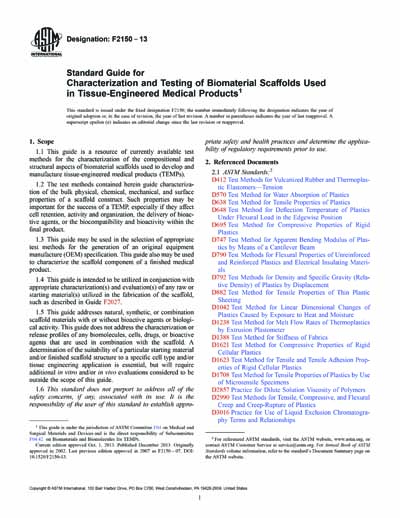Historical
ASTM F2150-13
Standard Guide for Characterization and Testing of Biomaterial Scaffolds Used in Tissue-Engineered Medical Products
1.1 This guide is a resource of currently available test methods for the characterization of the compositional and structural aspects of biomaterial scaffolds used to develop and manufacture tissue-engineered medical products (TEMPs).
1.2 The test methods contained herein guide characterization of the bulk physical, chemical, mechanical, and surface properties of a scaffold construct. Such properties may be important for the success of a TEMP, especially if they affect cell retention, activity and organization, the delivery of bioactive agents, or the biocompatibility and bioactivity within the final product.
1.3 This guide may be used in the selection of appropriate test methods for the generation of an original equipment manufacture (OEM) specification. This guide also may be used to characterize the scaffold component of a finished medical product.
1.4 This guide is intended to be utilized in conjunction with appropriate characterization(s) and evaluation(s) of any raw or starting material(s) utilized in the fabrication of the scaffold, such as described in Guide F2027.
1.5 This guide addresses natural, synthetic, or combination scaffold materials with or without bioactive agents or biological activity. This guide does not address the characterization or release profiles of any biomolecules, cells, drugs, or bioactive agents that are used in combination with the scaffold. A determination of the suitability of a particular starting material and/or finished scaffold structure to a specific cell type and/or tissue engineering application is essential, but will require additional in vitro and/or in vivo evaluations considered to be outside the scope of this guide.
1.6 This standard does not purport to address all of the safety concerns, if any, associated with its use. It is the responsibility of the user of this standard to establish appropriate safety and health practices and determine the applicability of regulatory requirements prior to use.
Content Provider
ASTM International [astm]






